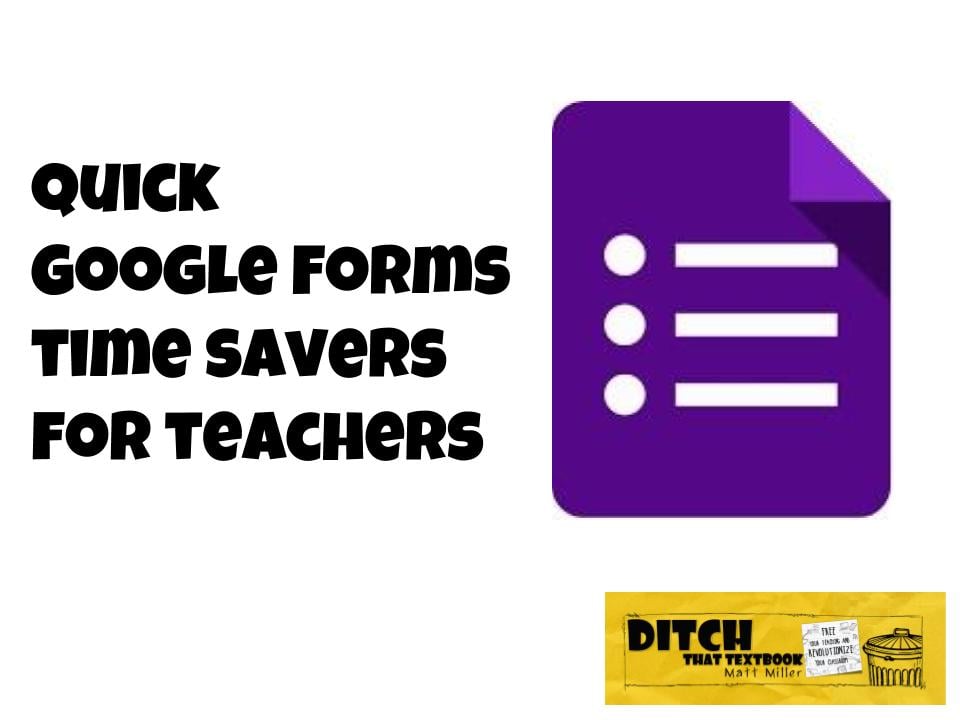

Google Forms is a great survey tool. It can also let us gather and organize our own data, saving us LOTS of time.
Google Forms is a great tool for surveying others and collecting data from them. By using Forms in that way, it can save us tons of time.
It can save us even more time when we survey ourselves.
I can hear your response to that one …
Wait, Matt … survey ourselves? Have you gone crazy?
Let me explain with an example.
There was a time when I wanted to input grades in my gradebook quickly as I walked around the room checking student work. Our gradebook program just didn’t have a good option for that.
So I created my own with Google Forms. Instead of using a Google Form for others to fill out, I used it for myself. I made a form with the following data fields:
… and on and on and on. I bookmarked the form on my iPad. When it was time to grade, I clicked on that bookmark, filled in the date and the assignment, and started logging grades.
The grades were saved automatically in a spreadsheet. It was easy to transfer them over to my gradebook afterward.
Afterward, I started thinking, “How else can I collect data from myself using Google Forms?”
And the logical follow-up question was, “How can my students use Google Forms to collect data from themselves?”
In this post, I’ll show you …
Creating a new Google Form isn’t hard. But I’ve recently learned of a faster way to do it …
http://forms.google.com/create
Enter this URL in a web browser and it automatically creates a fresh, new Google Form for you. No going to Drive and clicking the “New” button. No hassle. Just gets you started.
PS: This works with most Google file types. Some examples:
If you use your bookmarks bar in Google Chrome or create home screen shortcuts on an iPad or a tablet, you can add these URLs as bookmarks or shortcuts. That means one-click creation of a new Google file. Time and effort saved instantly.
If you aren’t super familiar with creating Google Forms, they’re not too hard to figure out. Start a new Google Form (see above). Then, use the circle “+” button in the top right of your screen to add new fields to the form. (If you’re using an iPad, tablet or mobile device, that button may be at the bottom.)
A field could be a place to fill in a short answer, choose from multiple choices, choose the date, etc. You’ll see all of the options when you click on the circle “+” button.
Just create the form out of the fields you’d like to include. It can be more advanced than that, but that’s the gist of it.
The data is saved in the Google Form (“Responses” tab), but it can also be saved in a spreadsheet. (Click the “Responses” tab, then the little green spreadsheet icon.)
I recently created a workout log. As a sort of New Year’s resolution, I’m getting in the habit of working out several days a week. (I started typing that sentence by saying, “I’m trying to get in the habit …” and changed it. The power of stating your goals as fact!)
I figured it would be really easy to do if I just had to click an icon on my phone, enter a couple items and click submit. I wouldn’t need a paper log, so I could access it anywhere. And I’d be done in a matter of seconds.
Here’s what my form looks like:
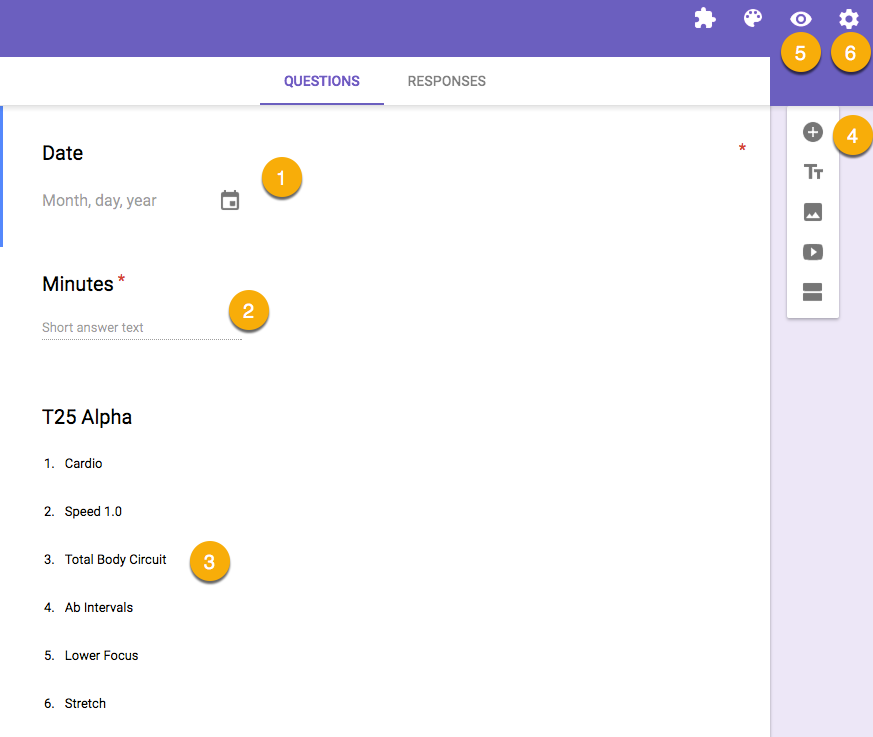
I used the “+” button (#4 in the image above) to add new fields. Some notes from this screenshot:
1. The date field makes it easy (and fast) to select from a calendar instead of typing it in.
2. This is a short answer field so I can type in an answer. (Pro tip: I used data validation to make sure that what I typed in was a number. Click the three dots in the bottom right corner of the text field, then choose data validation. In the dropdown box, I used: “number is a number.” Sounds silly and redundant, but it works!)
3. This is a dropdown answer field. I just added all the possible options. (Note: Another way to save time in Google Forms: When you’re done typing an option and want to skip down to a new line, just hit enter.)
4. This is where it all happens. The “+” button adds new questions and data fields to the form.
5. When you’re done — or want to see what it looks like — click the eyeball icon to preview.
6. The settings button. There are lots of options here, but for our purposes (making forms to gather data from yourself), the two most useful are:
These are some ideas that will help if you’re making forms to gather data from yourself. (Really, in any type of Google Form, these tips can be useful!)
1. Choose wisely. The dropdown menu, the multiple choice and the checkbox options are similar, but you’ll want to use them in unique situations:
2. Required is your friend. There’s an option at the bottom of a question/data field to make that question required. If an answer is crucial to have and you want to make sure that you don’t accidentally forget to add it, make that question/data field required.
3. Get the right data with data validation. When you create a new question/data field, use the three dots in the bottom right corner of that field and choose data validation. This sets up a rule for data typed into that field. If the rule is broken (i.e. it must be an email address, it must be a number greater than zero), the form gives an error and you can’t submit. This is an easy to way to prevent typos.
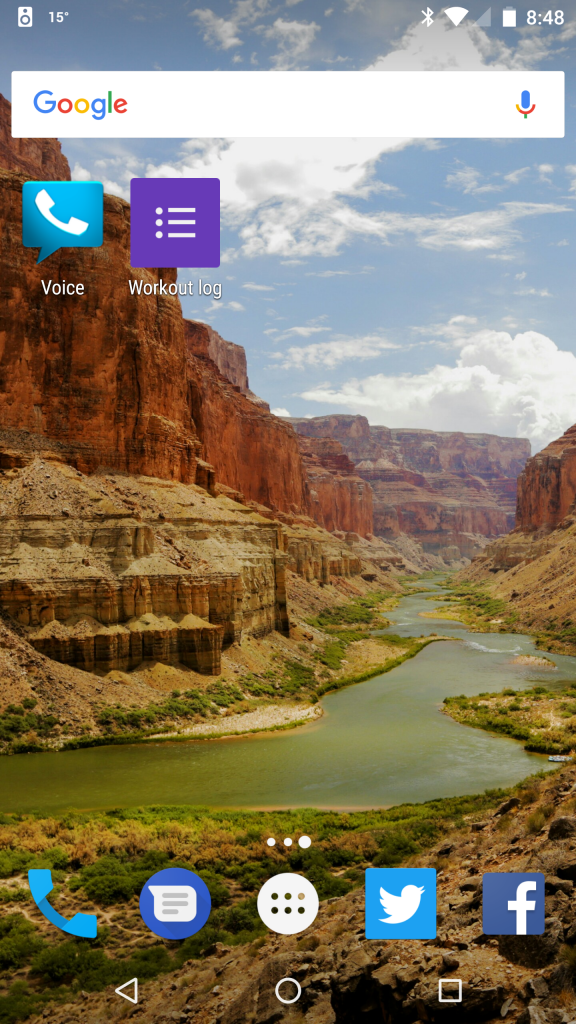
See that little purple button? That’s the link I added to my form on the home screen of my phone. (PS: It’s 15 degrees outside … brrr …)
4. Shortcuts/bookmarks = game changers. When you create a button or bookmark to a form, you save yourself time exponentially over digging it out of your Drive. A few easy ways to create a button on your phone or a bookmark in your browser:
When you have the form open …
You can also create a bookmark/home screen button for the spreadsheet with all of the results if you want to pull that up quickly as well.
5. (PRO TIP) Prefilled links save you even more time!: What’s faster than filling in a quick form to gather data? Having some of the questions/data fields already filled in for you.
These are called “prefilled links.” Click on the three dots in the top right of the screen. Choose “Get prefilled link”. Fill in the form the way you’d like to load it up every time. (i.e. If most students get a 10/10 on an assignment, you can prefill the form with all 10’s and change any that aren’t 10’s.) When you’re done, click submit. The form gives you a link you can use to load up that prefilled survey.
And yes, you can create a bookmark or home screen button to that prefilled link, too.
Instead of giving you 20+ ways to use these forms in class, just ask yourself this question:
When do I write down data I need to hold onto? (Especially on a regular basis.)
Then create a form that gathers that very data. Pretty simple.
Here are some examples to help generate some ideas. Click the links above the screenshots to see the forms in action.
If you have ideas of your own — either theoretical you just thought of OR something you or students have actually tried — PLEASE let us know in the comments!

A meal log (to go along with the workout log)
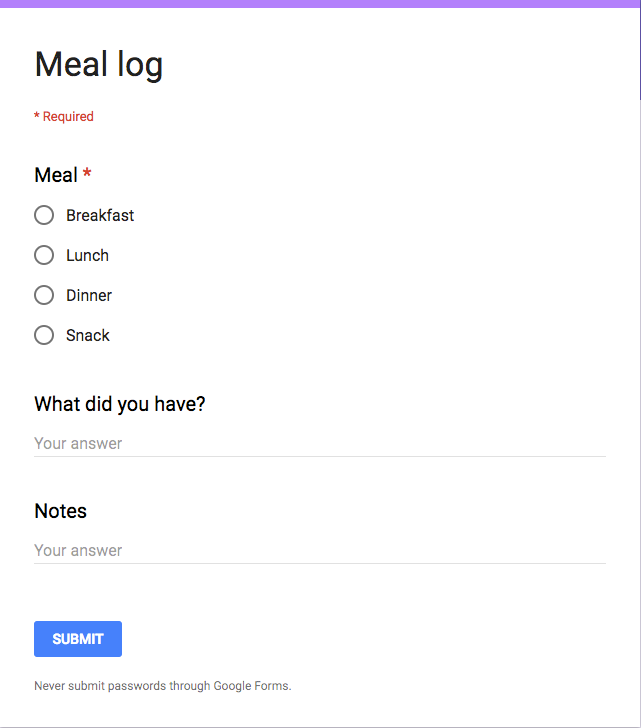
Student notes (used to write down feedback or documentation for particular students)
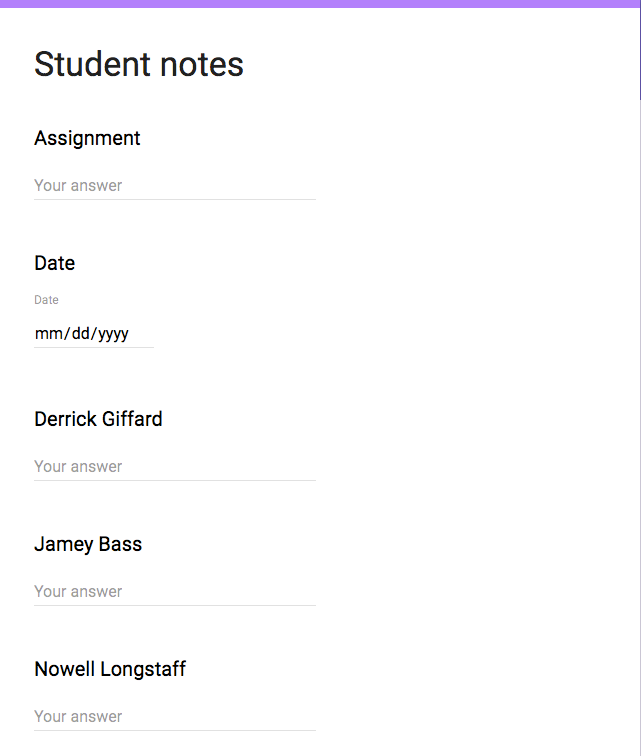
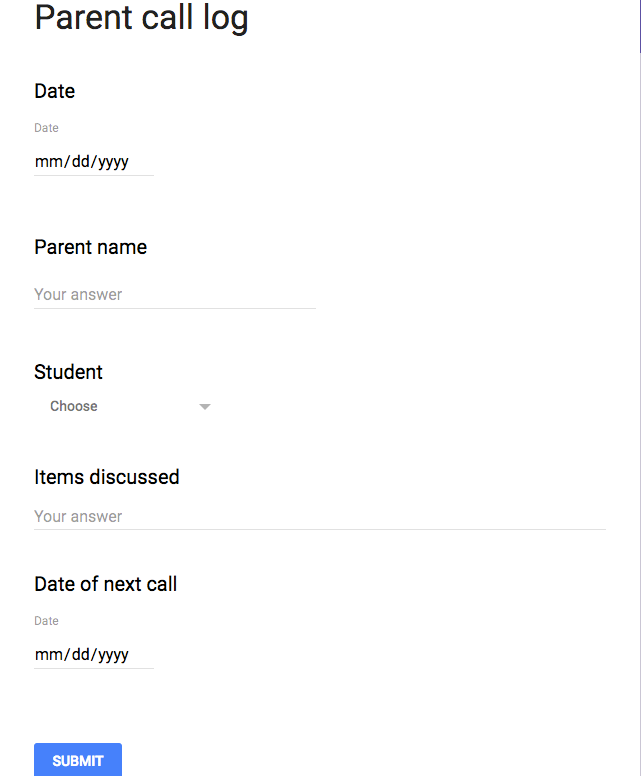
Other ways this could be used include a textbook log (if you haven’t ditched your textbooks yet!), saving random ideas that come to mind (like using sticky notes … although Google Keep is a GREAT digital sticky note tool) or student reading logs, exercise logs or nutrition logs.
The blog post below has lots of other ways to use Google Forms in the classroom. They could inspire you with new ways to use Forms yourself:
https://ditchthattextbook.com/2016/09/08/20-practical-ways-to-use-google-forms-in-class-school/
[reminder]How else could you use Google Forms to gather data from yourself? How could students use it in that way, too?[/reminder]For notifications of new Ditch That Textbook content and helpful links:
Interested in having Matt present at your event or school? Contact him by e-mail!
Matt is scheduled to present at the following upcoming events:
[getnoticed-event-table scope=”upcoming” max=”15″ expanding=”false”]
Session expired
Please log in again. The login page will open in a new tab. After logging in you can close it and return to this page.
This is a perfect example of why Forms can save anyone time. My favorite use is for skills we are attempting to master in gifted class. It is so much easier to track logical reasoning, critical thinking, creativity, social understanding, self-actualization to name a few, as well as subsets like number sense, idea or solution finding.
PARENT LOG – GENIUS!
Thank you!
[…] Quick Google Forms Time Savers for Teachers– Have you thought of using forms to help you collect data, and not just surveys. Matt Millers offers some pointers. […]
[…] Quick Google Forms time savers for teachers | Ditch That Textbook […]
Great post, Matt! I love your ideas. The best way I have started using Google Forms is for teachers to submit their request for PGPs after we work together during their prep period, before school, or after school. Then with the lovely Google Sheets add-on, Autocrat, they get their own PGP certificate sent back to them. By automating the process, it has sped up my life. 🙂
[…] Source: Quick Google Forms time savers for teachers | Ditch That Textbook […]
I use Google forms to keep track of bills I’ve paid and bills I still need to pay. I use checkboxes for the ones that autopay as well as those that are amounts. I use short answers for bills that change in amount, like the electric bill for example. I’m eager to try some of these other ideas.
Oh I would love to see an example of this form!
I would also love to see a sample of your Form. Would you mind sharing Carina? It sounds awesome.
Thank you
I use Forms to keep track of small group notes. I use a checklist of mastered, working toward mastery, need help, or absent. Then there is section for any notes.
Google Forms were my very FIRST Google love! A great starting point for those new to Forms is to think of it as an electronic scantron for a quiz or test. If the thought of converting to digital assessments 100% is daunting, just number out questions to match your paper quiz and leave all the text off. You’ll quickly see how easy it is and you’ll be on your way!
To your list of recommendations for the Dropdown menu, I would add options that are repeated over several questions. In my German classes, for example, I will put all possible conjugations of a verb in a dropdown menu, while letting students select the correct one for the sample sentence I give.
I have made a google form for my administrators to do walk-through evaluations of their staff.
I work as technology integration specialist at the district level and wanted to track the appointments I had with folks in various buildings, about how much time I spent with them, what we worked on and whether I needed to follow up on the visit later and how (email, in person, etc.) I created a Google Form to collect my data and saved the link to the live form on all my devices (iPhone and iPad as a web clip, and as one of the tabs that load whenever Chrome opens on my laptop. It was a great way to analyze data about how I spend my time and easy to complete after each meeting.
As a learning support specialist, I needed to keep anecdotal notes on my students to assist with adaptations and modifications to curriculum, behavior, etc. Google Forms on my iPad was the way to go!. I was able to sort the information, copy, paste and review quickly besides being able to forward to the staff needing the notes.
I’ve been enamored of the idea of “real world choice” Spanish homework, but after trying one semester of blog posts about their homework, I was completely burnt out. They weren’t sharing with each other, and navigating to each individual blog was time consuming, disorienting and overall uncomfortable. I think it would be better to have students use Google Forms to track their own RWC homework, then submit their spreadsheet to me once a month, or something like that.